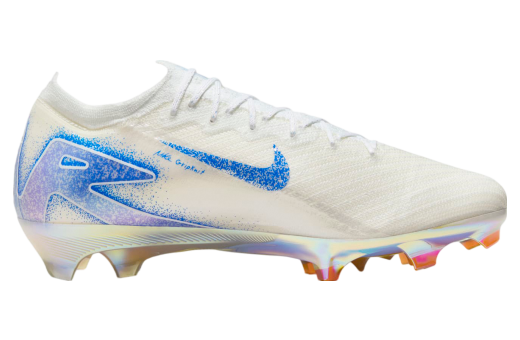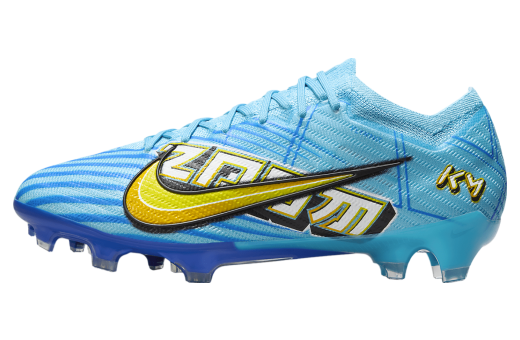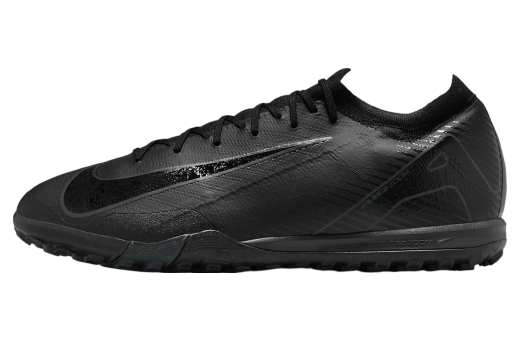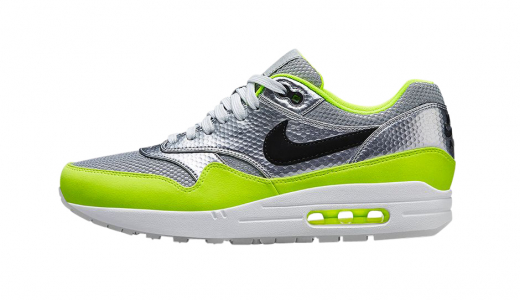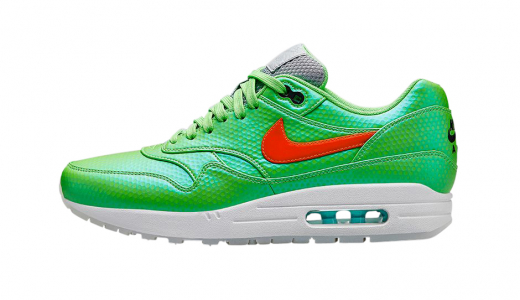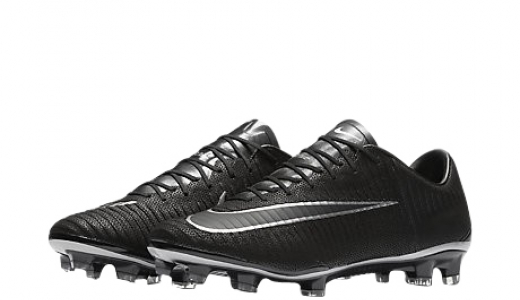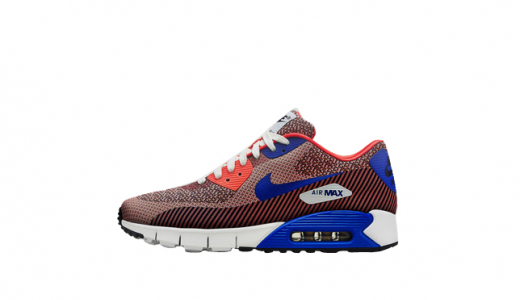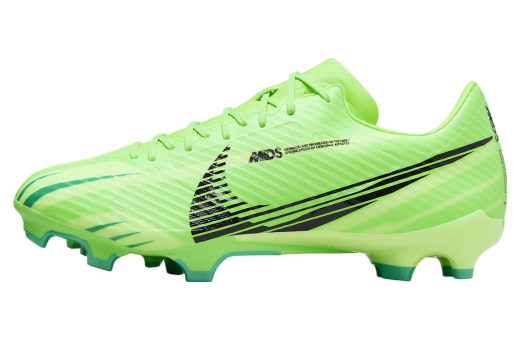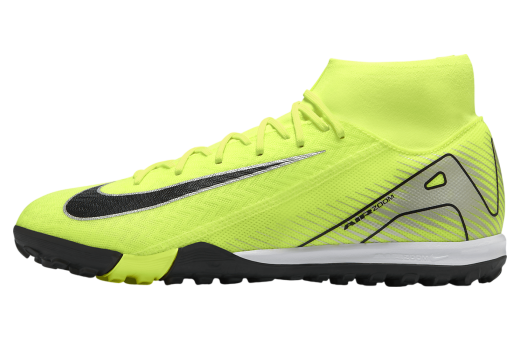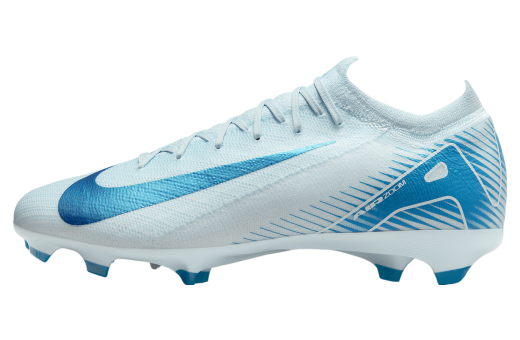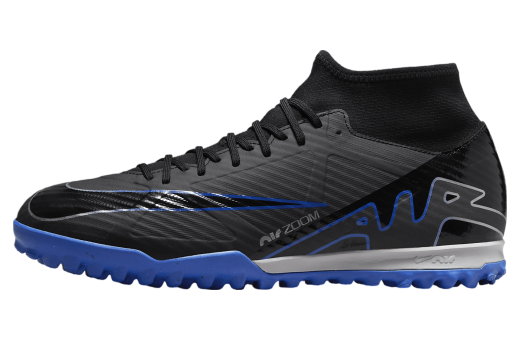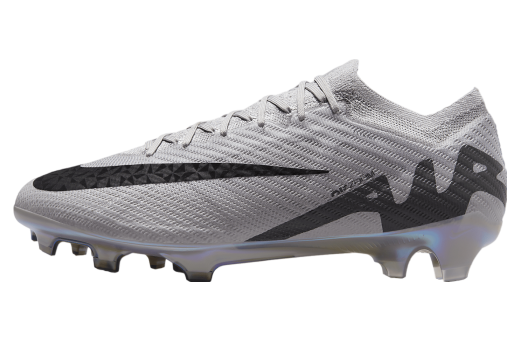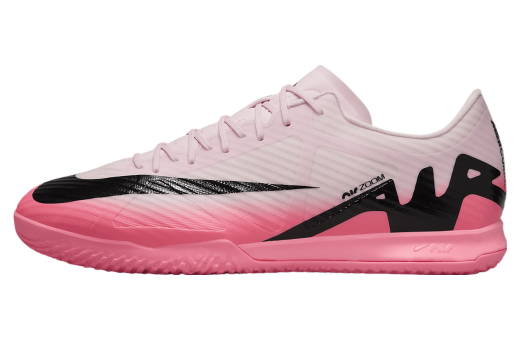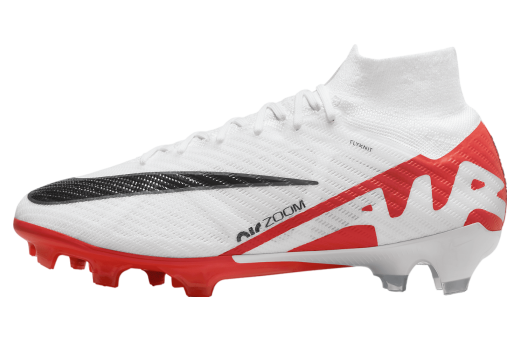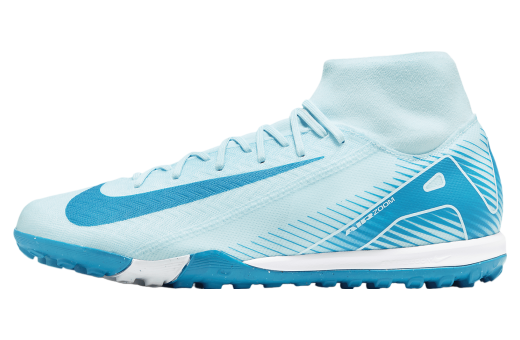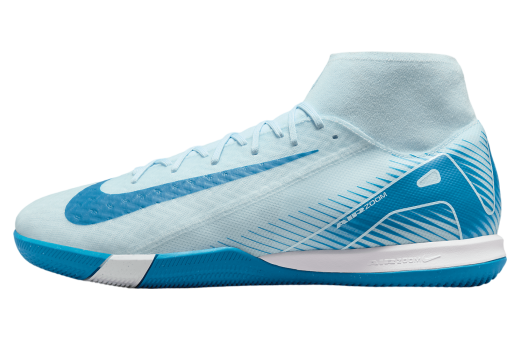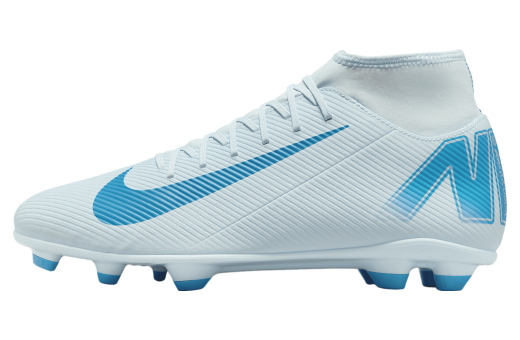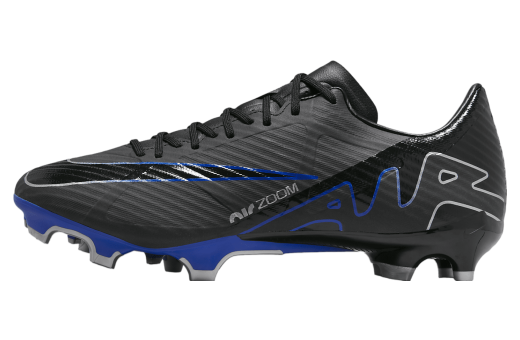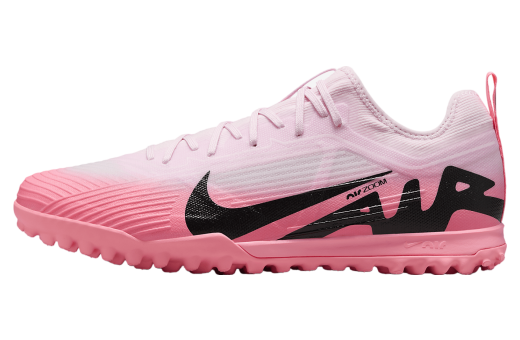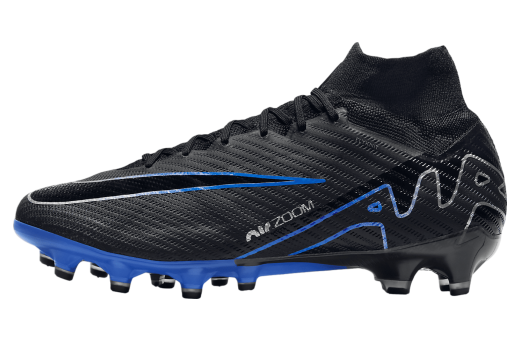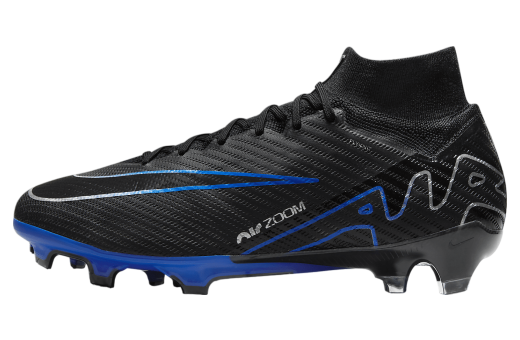Nike Mercurial
The Nike Mercurial line is a popular series of soccer cleats and footwear that has been a game-changer in the world of football since its introduction in 1998. Designed with speed and performance in mind, the Mercurial series has continually evolved, incorporating the latest technologies and materials to enhance player agility and traction on the field. The initial concept behind the Mercurial line was to create a lightweight boot that allows for explosive speed and superior control, catering to the needs of some of the world's fastest and most skilled players. Over the years, the Mercurial has been donned by soccer legends and top athletes, including Cristiano Ronaldo, who has had several signature editions released under this line.
Nike has kept the Mercurial series at the forefront of innovation by constantly experimenting with new designs and technologies. For instance, the introduction of Flyknit technology provided a seamless, sock-like fit, while All Conditions Control (ACC) ensures optimal ball control in both wet and dry conditions. The soleplate design has also seen numerous advancements, focusing on minimizing weight while maximizing responsiveness and grip on various surfaces. Additionally, Nike has customarily involved direct input from professional players in the design process to ensure that each new iteration of the Mercurial meets the high-performance standards required at the elite level of the sport. This constant pursuit of excellence has cemented the Mercurial's reputation as one of the most preferred and iconic soccer cleat lines in history.
History of Nike Mercurial
The History of Nike Mercurial
The Nike Mercurial series has become one of the most iconic and influential line of football boots in history. Since its inception in 1998, the Mercurial has seen incredible advancements in technology, design, and performance. This comprehensive history details its origins, evolution, and impact on the world of football.
Origins: 1998 - 2000
The story of the Nike Mercurial begins in 1998, a landmark year for Nike in football as they sought to revolutionize the football boot market. The goal was to create a boot tailored to the needs of the fastest players in the game. Nike focused on three main aspects: speed, lightweight construction, and minimal design.
Mercurial R9: The Birth of the Legend
The first Mercurial model was developed with the help of Brazilian superstar Ronaldo, nicknamed "O Fenômeno." The R9, named after Ronaldo, debuted just before the 1998 FIFA World Cup in France. It featured a thin, synthetic KNG-100 material designed to be lighter and more responsive than traditional leather boots. This synthetic material was a groundbreaking invention, as it reduced the boot's weight significantly while maintaining durability and proper fit.
The R9's striking appearance, with its silver, blue, and yellow colorway, along with the new technology, generated significant buzz. Ronaldo wore them throughout the World Cup, cementing the Mercurial's association with speed and agility. Despite Brazil losing in the final, Ronaldo's performance in the boots caught the world's attention.
The Early 2000s: Evolution and Experimentation
After the success of the R9, Nike continued to push the boundaries of boot technology and design. The early 2000s saw several iterations and significant improvements that broadened the Mercurial's appeal.
Mercurial Vapor: Setting New Standards
In 2002, just in time for the FIFA World Cup in South Korea and Japan, Nike released the Mercurial Vapor. This model was even lighter than its predecessors, weighing in at approximately 200 grams. The Vapor was constructed of Teijin synthetic leather, which was even thinner and more lightweight than the KNG-100 material.
The design of the Mercurial Vapor was sleek and minimalist, defining a new aesthetic for football boots. The Vapor featured a bold blue colorway with a white Nike swoosh, making it instantly recognizable. The boot was not just about looks; the improved traction system with a new traction plate and strategically placed studs provided better grip and acceleration.
Ronaldo continued as the face of the Mercurial line and wore the Vapor during the 2002 World Cup, where he famously scored twice in the final against Germany, leading Brazil to a fifth World Cup victory.
Mid-2000s: Refinement and Consolidation
As the Mercurial line matured, Nike began to refine the boots, improving comfort, performance, and style while maintaining the core philosophy of speed.
Mercurial Vapor II and III
In 2004 and 2006, Nike released the Mercurial Vapor II and III. These iterations brought incremental improvements, including better fit, enhanced materials, and further weight reduction. Both models retained the lightweight synthetic uppers and focus on speed.
One significant innovation during this period was the introduction of Nike's carbon fiber soleplate, improving energy return and reducing weight even further. The colorways for the Vapor II and III grew bolder, with vibrant oranges, greens, and even a chrome version that turned heads on the pitch.
Endorsements and Popularity
Throughout the mid-2000s, Nike aggressively promoted the Mercurial line by signing top footballers. Cristiano Ronaldo, Thierry Henry, and Zlatan Ibrahimović became ambassadors for the line, wearing different Mercurial models during key moments in their careers. Their endorsement played a crucial role in cementing Mercurial's reputation as the boot for elite, fast players.
Late 2000s: Technological Innovation
The late 2000s marked a period of significant technological innovation for the Mercurial series. As the line evolved, Nike introduced cutting-edge technologies to enhance player performance.
Mercurial Superfly: The Quantum Leap
In 2009, Nike launched the Mercurial Superfly, a game-changer in football boot technology. The Superfly was developed in collaboration with some of the fastest players in the game, including Cristiano Ronaldo. This model was notable for several revolutionary features.
The Superfly featured a Flywire technology for the first time in football boots. Flywire consisted of high-strength fibers that provided support and a dynamic fit, similar to a second skin. This technology reduced the weight and improved the boot's fit and responsiveness.
Another major innovation was the carbon fiber soleplate, which provided increased strength and reduced weight. The combination of Flywire and carbon fiber made the Superfly one of the lightest and most advanced boots on the market. Cristiano Ronaldo showcased its capabilities on numerous occasions, further boosting its popularity.
Mercurial Legacy Continues
Nike continued to enhance the Mercurial line in the years following the Superfly's release. The Mercurial Vapor IV and V incorporated improvements based on player feedback, such as better traction patterns, enhanced durability, and refined aesthetics.
2010s: Dominance and Diversification
The 2010s were a decade of dominance for the Nike Mercurial series. Nike's relentless pursuit of innovation and dedication to player needs led to various models and versions that further solidified the Mercurial's status as the ultimate boot for speed and agility.
Mercurial Vapor VIII
In 2012, Nike introduced the Mercurial Vapor VIII. This model had a sleeker silhouette and a redesigned soleplate for improved traction and stability. The upper material was a specially engineered Teijin synthetic leather that provided a glove-like fit and exceptional touch.
The Mercurial Vapor VIII also marked a shift towards eco-friendly practices, with materials and production methods designed to reduce the boots' environmental footprint. The bold orange and black colorway was iconic and highly visible on the pitch.
Mercurial Superfly IV and V
The Mercurial Superfly IV, released in 2014, continued the tradition of innovation. Nike introduced Flyknit technology to the Superfly line, creating a seamless, sock-like fit. The Dynamic Fit collar extended above the ankle, providing additional support and a more integrated feel with the foot.
The Superfly IV was a watershed moment for football boots, revolutionizing how players experienced fit and comfort. The carbon fiber soleplate and Flyknit upper made the boot exceptionally light and responsive.
In 2016, the Mercurial Superfly V took the advancements even further. The improved Flyknit upper had a ribbed texture for better ball control, and the Dynamic Fit collar was refined for even greater comfort. The soleplate was re-engineered for optimal traction and acceleration.
Cristiano Ronaldo and Mercurial CR7
Cristiano Ronaldo continued to be the face of the Mercurial line, and in 2015, Nike launched a special CR7 series dedicated to the Portuguese superstar. The CR7 boots featured unique colorways and design elements that reflected Ronaldo's personality and career highlights. These limited-edition boots became highly sought after by fans and collectors alike.
Late 2010s and Early 2020s: Continual Innovation
The late 2010s and early 2020s saw Nike building on the strong foundation of the Mercurial line while continuing to push the boundaries of football boot technology.
Mercurial Vapor XII and XIII
In 2018, Nike released the Mercurial Vapor XII. This model featured a completely Flyknit upper with a one-piece construction for enhanced fit and comfort. The all-new 3D Speed Rib texture on the upper improved ball control and touch. The split soleplate design reduced weight and provided greater flexibility.
The Mercurial Vapor XIII, released in 2019, further refined the Flyknit upper with high-strength yarns and a tighter weave for a closer fit. The Aerotrak Zone in the forefoot provided explosive acceleration and better traction, making it one of the best boots for speed-focused players.
Superfly VII and VIII
The Mercurial Superfly VII and VIII, launched in 2019 and 2021, respectively, continued to build on the legacy of their predecessors. The Superfly VII featured a streamlined design, improved fit, and enhanced traction. The Flyknit upper and Dynamic Fit collar provided exceptional comfort and support.
The Superfly VIII introduced the NikeGrip technology in the insole to prevent internal slippage, ensuring that players could make the most of their speed and agility. The boot's design featured vibrant and eyecatching colorways, making a bold statement on the pitch.
Impact and Legacy
The Nike Mercurial series has had a profound impact on football boot design, technology, and culture. Here are some key aspects of its enduring legacy.
Revolutionizing Speed
The Mercurial line's primary focus on speed has changed the way football boots are designed. Nike's innovative use of lightweight materials, advanced construction techniques, and technologies like Flyknit and Flywire have set new standards for performance and comfort. The Mercurial boots have helped players achieve new levels of speed and agility, transforming the game.
Influencing Design Trends
The Mercurial's bold and futuristic designs have influenced football boot aesthetics across the industry. The use of vibrant colorways, sleek silhouettes, and dynamic patterns has become a trend widely adopted by other brands. The Mercurial's visual appeal has made it a favorite not only among professional players but also among amateur footballers and fashion-conscious individuals.
Iconic Player Endorsements
The association with some of football's greatest players, including Ronaldo, Cristiano Ronaldo, Thierry Henry, and Neymar Jr., has cemented the Mercurial's status as the boot of choice for the world's best. These endorsements have showcased the boots' capabilities at the highest level of the game and contributed to their widespread popularity.
Constant Innovation
Nike's commitment to innovation has been the driving force behind the Mercurial's success. Each new iteration has introduced cutting-edge technologies and materials, ensuring that the boots remain at the forefront of performance. From the early days of synthetic uppers to the latest advancements in Flyknit and carbon fiber, the Mercurial line has consistently pushed the boundaries of what is possible in football boot design.
Conclusion
The history of the Nike Mercurial is a testament to the power of innovation, technology, and design in sports. From its debut in 1998 with the Mercurial R9 to the latest models in the early 2020s, the Mercurial series has continually evolved to meet the demands of the modern game. It has redefined the standards for speed and performance, leaving an indelible mark on football history. As Nike continues to push the boundaries of what is possible, the legacy of the Mercurial line will undoubtedly endure for generations to come.
